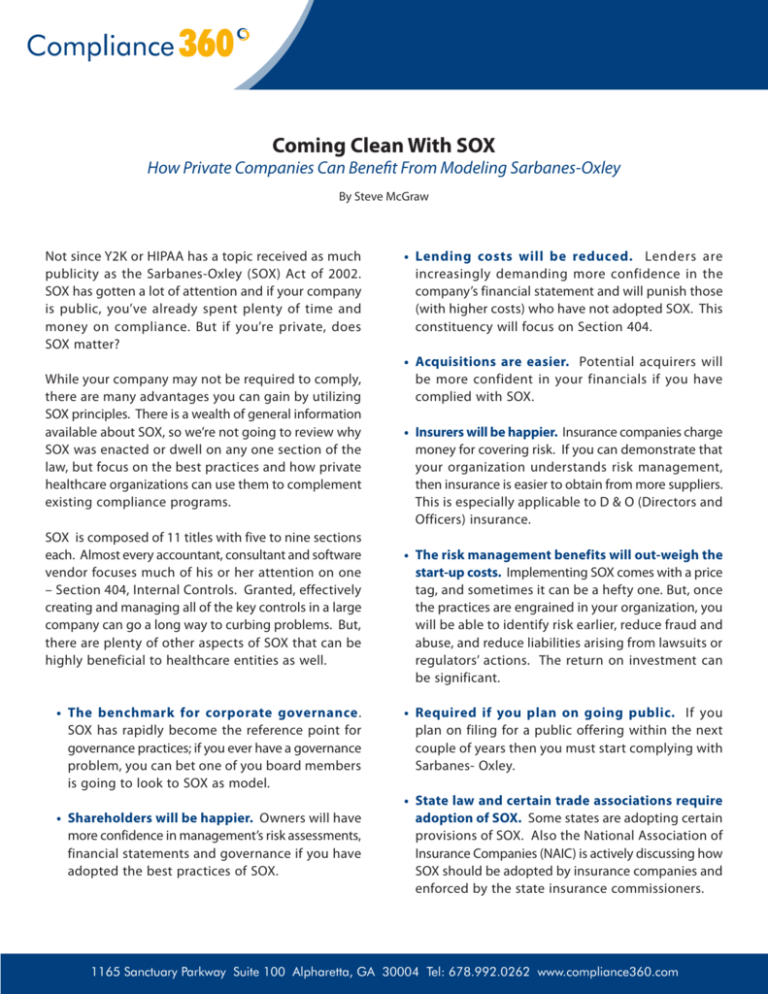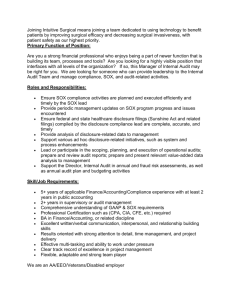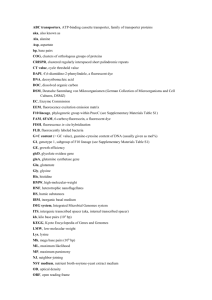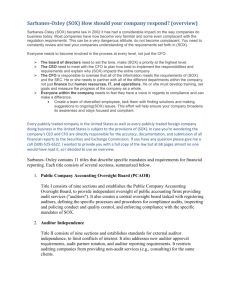Coming Clean With SOX
advertisement

Coming Clean With SOX How Private Companies Can Benefit From Modeling Sarbanes-Oxley By Steve McGraw Not since Y2K or HIPAA has a topic received as much publicity as the Sarbanes-Oxley (SOX) Act of 2002. SOX has gotten a lot of attention and if your company is public, you’ve already spent plenty of time and money on compliance. But if you’re private, does SOX matter? While your company may not be required to comply, there are many advantages you can gain by utilizing SOX principles. There is a wealth of general information available about SOX, so we’re not going to review why SOX was enacted or dwell on any one section of the law, but focus on the best practices and how private healthcare organizations can use them to complement existing compliance programs. SOX is composed of 11 titles with five to nine sections each. Almost every accountant, consultant and software vendor focuses much of his or her attention on one – Section 404, Internal Controls. Granted, effectively creating and managing all of the key controls in a large company can go a long way to curbing problems. But, there are plenty of other aspects of SOX that can be highly beneficial to healthcare entities as well. • The benchmark for corporate governance. SOX has rapidly become the reference point for governance practices; if you ever have a governance problem, you can bet one of you board members is going to look to SOX as model. • Shareholders will be happier. Owners will have more confidence in management’s risk assessments, financial statements and governance if you have adopted the best practices of SOX. • Lending costs will be reduced. Lenders are increasingly demanding more confidence in the company’s financial statement and will punish those (with higher costs) who have not adopted SOX. This constituency will focus on Section 404. • Acquisitions are easier. Potential acquirers will be more confident in your financials if you have complied with SOX. • Insurers will be happier. Insurance companies charge money for covering risk. If you can demonstrate that your organization understands risk management, then insurance is easier to obtain from more suppliers. This is especially applicable to D & O (Directors and Officers) insurance. • The risk management benefits will out-weigh the start-up costs. Implementing SOX comes with a price tag, and sometimes it can be a hefty one. But, once the practices are engrained in your organization, you will be able to identify risk earlier, reduce fraud and abuse, and reduce liabilities arising from lawsuits or regulators’ actions. The return on investment can be significant. • Required if you plan on going public. If you plan on filing for a public offering within the next couple of years then you must start complying with Sarbanes- Oxley. • State law and certain trade associations require adoption of SOX. Some states are adopting certain provisions of SOX. Also the National Association of Insurance Companies (NAIC) is actively discussing how SOX should be adopted by insurance companies and enforced by the state insurance commissioners. 1165 Sanctuary Parkway Suite 100 Alpharetta, GA 30004 Tel: 678.992.0262 www.compliance360.com SOX Best Practices and How Private Companies Can Utilize Them While private companies aren’t required to comply with any of these regulations, obviously some of them can enhance compliance programs while producing many of the benefits we discussed above. Let’s take a look at SOX, title by title. In order for you to have a good idea of the titles that can benefit you and the ones that can be ignored, we’ll use the common “five stars” rating system. If a regulation only merits one or two stars, you can pay less attention; but those with five stars have the potential to knock your SOX off. Title I. Title I establishes the Public Company Accounting Oversight Board. Private companies can safely ignore this one. Title II. - Auditor Independence Section 201: Services Outside the Scope of Practice of Auditors This section requires that your audit firm perform no other services but the audit. The purpose is to eliminate any conflict of interest from the auditors. If you think about the situation, your audit firm has direct access to the most influential leaders in your company. If they are allowed to sell other services such as IT project management, legal services or internal audit functions, there could be excessive influence or conflict of interest. In the past, the audit firm that sold a wide range of services had broad scope over rules of evaluation and procurement. SOX helps ensure that auditors are truly independent and not unduly influenced by other business opportunities they may have within the account. Section 203: Audit Partner Rotation If you are a private company, audit partner rotation is more subjective. Over the course of doing business with you, your audit firm builds up a great deal of expertise concerning both your industry and firm. Auditors know your key controls, your joint ventures, major vendor agreements, compensation agreements, etc. Your healthcare auditor is not only an accounting expert but also a student of coding and billing practices, Stark self-referral, anti kickback statutes and other OIG requirements. Do you really want to trade this person out and educate a brand new partner every few years? If you are public company the law is clear and you must, but if you are private the value of adopting such a practice is debatable and you may be better off keeping the auditor who knows the ins and outs of your business. Section 204: Audit Firm Reports to the Audit Committee Your audit firm should report to the Audit Committee. The purpose here is clear there should be no appearance of influencing or filtering results. This opens other important issues, such as within your company, who should report to the Audit Committee? Moreover, what is the role of the Chief Compliance Officer? Section 301 establishes the requirements for the Audit Committee, but SOX does not directly discuss the internal reporting structure to the Audit Committee. In our discussions with hundreds of healthcare companies, we’ve seen scores of reporting permutations. Most are flawed and have some historical and political rationale. The right answer is actually pretty simpleand that is that the company should establish a Chief Compliance Officer and the CCO should report to the Audit Committee. The CCO should be responsible for all compliance activities, fraud and abuse, enterprise risk management and generally be accountable for ensuring that programs are in place to demonstrate compliance with all laws, regulations and standards. The CCO should have responsibility for Internal Audit, CMS requirements, state audits, the hotline, corporate policy, and oversight of the quality programs such as NCQA, URAC or Joint Commission. 1165 Sanctuary Parkway Suite 100 Alpharetta, GA 30004 Tel: 678.992.0262 www.compliance360.com Title III. - Corporate Responsibility There are two sections that stand out as best practices for privately held healthcare organizations in this title: Section 301 and Section 302. The rest of Title III is a grab bag of various rules designed to enforce accountability at the officer and board level as well as a series of guidelines for particular behavior and certain transactions. Most of these rules and guidelines have little applicability to private healthcare concerns, but 301 and 302 can be helpful. Section 301: Public Company Audit Committee This section establishes the guidelines of the Audit Committee. There is a lot of material on this subject and it is better explored by a Board of Directors, which can review the subject in much more detail than we can provide here. A very useful site is: http://www. aicpa.org/audcommctr/homepage.htm. There are some basics to the Audit Committee that may serve, however, to get you started. The Audit Committee: • Establishes a chart of responsibility and corporate governance. • Contains independent members. • Establishes a method for receiving confidential complaints from vendors, employees and others in regards to accounting irregularities. Establish a chart of responsibility and corporate governance. These are auditing functions and any other items that could have an impact on financial performance and company valuation. You can locate a thorough checklist at the AICPA web site, mentioned above. Examples of these auditing functions are, for instance, that the Audit Committee should conduct executive sessions, hire the outside auditors, review management travel and expense policies, review adequacy of internal controls, and understand all regulatory and legal proceedings impacting the company. Each member of the Audit Committee should be independent. • A member should not have been employed by the company for at least five years. • A member should not currently be a director of a company where anyone on the management team also serves as a director. • A member should not perform business with the company as a customer, consultant, supplier, or have interest in a firm that conducts business with the company. • A member should not have a relationship with a joint venture, subsidiary or other affiliate of the company. Establish a method for receiving confidential complaints from vendors, employees and others in regards to accounting irregularities. Since the OIG requires a method of reporting fraud and abuse, nearly every healthcare company has a hotline. One hotline should support the SOX and OIG requirement. A quick primer on the role and importance of a hotline can be found at http://www.hotlines. com/sarbanes_oxley.htm Be advised that the penalty for retaliation against a whistleblower is steep. (See SOX Section 1107 for details.) Section 302: Corporate Responsibility of Financial Statement This section requires the senior officers to certify that the financial statements are complete and accurate. Section 302 directly correlates to Section 404. Without properly implemented internal controls, it is very hard to certify financial statements. However, company leaders must stand behind the company’s financial reports. 1165 Sanctuary Parkway Suite 100 Alpharetta, GA 30004 Tel: 678.992.0262 www.compliance360.com Title IV. - Financial Disclosures When most people refer to SOX, they are referring to this title and more specifically to Section 404. Broadly speaking, this title regulates off balance sheet transactions, loaning money to executives and directors, management assessment of financial internal controls, code of ethics, mandating a financial expert to the audit committee, and the reporting and timing of certain financial events. The effort is so daunting that many hesitate to start. If you identify the top 50 key controls, you soon will realize that there are some you just cannot ignore. Let’s look at an obvious example: coding and billing. You know there is a high risk of a billing error when you’re processing thousands of transactions, sometimes on a daily basis. With the OIG oversight and its related penalties, one would be foolish not to fully comply with Section 404. It is worth devoting at least a couple of paragraphs on this, the section that gets all the press, however, this is only a simple primer on the topic. Extensive information is available to help you build and manage internal controls. For books on this topic, see your auditor (or their web site), or go to http://www. coso.org/. Only by pinpointing all of your key controls and focusing on those with the highest risk and highest volume can you be more confident of having accurate statements and be certain that controls are in place to ferret out potential fraud and abuse. It may take two or more years to be fully compliant with 404, but this investment is definitely worth the time and money. First, what is an internal control? Internal controls are processes that help you achieve: Title V. - Analyst Conflict of Interest • Effectiveness and efficiency of operations • Reliability of financial reporting • Compliance with applicable laws and regulations Like any regulated business, healthcare organizations are complex. How do you ensure that your business is reporting numbers accurately? You have to develop key controls around the processes that affect your financial reporting. In short, you must do the following: 1. Identify the key processes and document them 2. Document policies and procedures 3. Define the control and the measurement for the control 4. Assess the effectiveness of the measurement I n any business, this process of identifying, documenting, defining, and assessing is a lot of work and it’s monumental in companies with stiff guidelines and reporting requirements. For most healthcare companies, Section 404 requires a significant amount of consulting, internal labor and new systems to achieve full compliance. Title V requires objectivity from the analysts and since analysts rarely follow private companies, this section does not apply. Title VI. - Commission Resources and Authority This Title provides the resource funding for the Commission and places some requirements on penny stocks and investment bankers. This section doesn’t apply to private companies. Title VII. - Studies and Reports This Title requires the Commission to report on various impacts of Sarbanes-Oxley. It does not apply to private companies. Title VIII. - Corporate and Criminal Fraud Accountability Title VIII discusses the various practices that constitute fraud and obstruction of justice. There are lots of modifications of existing law, which make for fairly difficult reading and require an attorney for a full explanation. We’ll take a brief look at the two sections 1165 Sanctuary Parkway Suite 100 Alpharetta, GA 30004 Tel: 678.992.0262 www.compliance360.com that are most pertinent to private companies. You’ll want to check with your Legal Department or an attorney for more information regarding Title VIII. Section 802: Criminal Penalties for Altering Documents This section forbids the alteration or destruction of documents when one expects to be part of an investigation. The real lesson inherent in this section is that companies should examine their record retention policy. Your records retention policy should be an integral part of your business, regardless of SOX. Your disaster recovery plan, various laws and standards, as well as just common business sense, require a document archive and retention plan. Implicit in this practice is the idea that you need to educate your people on your document retention policy and the potential penalties for failing to comply. Section 806: Protection of Whistle-blowers Whistle-blowers are specifically protected and penalties for retaliation are stiff. Have a disinterested party assess the whistle-blower directly to ascertain if he or she feels harassed. In a long investigation, this process should be done at least quarterly. Title IX. - White Collar Crime Penalty Enhancements This Title strengthens the penalties for fraud and abuse if you are a public company. Again, the act only applies to publicly traded companies, but it would be in every company’s best interest to take this regulation seriously. Summary Healthcare is a highly regulated industry with myriad rules, procedures, policies, and regulations. While Sarbanes-Oxley compliance is not required for private healthcare companies, they can certainly benefit from implementing some of its processes, which will help ensure overall compliance. SOX compliance can help any company execute greater internal control and improve its external image with stockholders, the community and customers alike. Numerous books have been written on SOX and there is a wealth of information available on the Internet, from auditors and other sources. By choosing to investigate and utilize the best practices of SOX, you help your private healthcare organization enhance compliance initiatives and operate more efficiently. Steve McGraw is the CEO of Compliance 360. Compliance 360 helps companies in regulated industries address the most important facets of a comprehensive compliance program— reducing risks, reducing costs, improving efficiencies and enhancing global visibility of compliance activities. Compliance 360 has headquarters in Atlanta, GA and serves over 200 customers in healthcare, financial services, managed care, life sciences, pharmaceutical and other complex business environments. For more information, visit Compliance 360 on the World Wide Web at www.compliance360.com. Title X. - Corporate Tax Returns This is the shortest title in the whole act – one sentence. It requires that the CEO sign the company’s federal tax returns. Title XI. - Fraud and Accountability This Title strengthens the existing law and the penalties for bad behavior. Section 1107 specifies that retaliatory actions against whistle-blowers can result in jail time up to ten years, among other punishments. 1165 Sanctuary Parkway Suite 100 Alpharetta, GA 30004 Tel: 678.992.0262 www.compliance360.com








